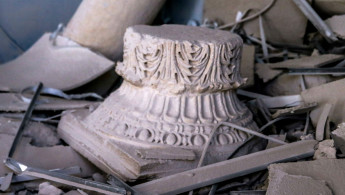US takes action to block resale of IS-looted antiquities
An ancient serpentine ring and gold coins trafficked by the Islamic State group could soon be recovered by the United State after it filed a case in court to retrieve the artefacts, in a move Washington claims is aimed at preventing stolen Syrian and Iraqi antiquities from disappearing into collectors' hands
The US attorney filed a forfeiture claim in the US District Court for the District of Columbia against the antiquities on Thursday, thought to be worth hundreds of thousands of dollars.
The action aims to warn would-be collectors that any purchase they might make could be contested, although officials fell short of disclosing the location of the artefacts, while suggesting they would "eventually" be returned to their rightful owners.
The antiquities, including a neo-Assyrian stele, were identified from cell-phone pictures and other electronic media seized from powerful IS commander Abu Sayyaf, who was killed in a US Special Operations raid in eastern Syria in May 2015.
Abu Sayyaf was in charge of raising money for IS from the antiquities trade, selling or taxing looted artefacts from the ancient and culturally rich region.
The group is believed to have raked in several million dollars from the lucrative trade, the US State Department said last year.
 |
The group is believed to have raked in several million dollars from the lucrative trade, the US State Department said last year |  |
US authorities recovered extensive records of the trade in the raid, including pictures, documentation of taxes collected and sales made. There was even a claim by traders who said an IS official cheated them out of some valuable items.
Assistant US Attorney Arvind Lal said the four items named in the seizure filing, the first of its kind, were the first which could be clearly identified and described for the legal action.
"When the raid was conducted on Abu Sayyaf, the United States collected a lot of electronic media," like cellphones, he told AFP.
"There were many, many images on that electronic media" of ancient artefacts.
The court action formally laid US claim to the items based on US sanctions against IS as a foreign terrorist group.
The aim, Lal said, is to put the global antiquities trade on notice that anyone who buys them will not have legal title to them.
Lal would not say if the US knows where the items are: a stunning gold ring with a serpentine cameo face of the Greek goddess Tyche from 330-400 AD; second-century Roman coins featuring Antoninus Pius and Emperor Hadrian Augustus Caesar; and a cuneiform stele possibly dating to the ninth century BC.
Lal said the aim is not for the US to take permanent control of the items, but eventually to return them to the authorities who are the rightful owners.
"Antiquities seized in the Abu Sayyaf raid were handed over to Iraq," he noted.





 Follow the Middle East's top stories in English at The New Arab on Google News
Follow the Middle East's top stories in English at The New Arab on Google News
![Both Hamas and the Palestinian Authority welcomed the ICC arrest warrants [Getty]](/sites/default/files/styles/image_330x185/public/2024-11/GettyImages-2178351173.jpg?h=199d8c1f&itok=TV858iVg)

